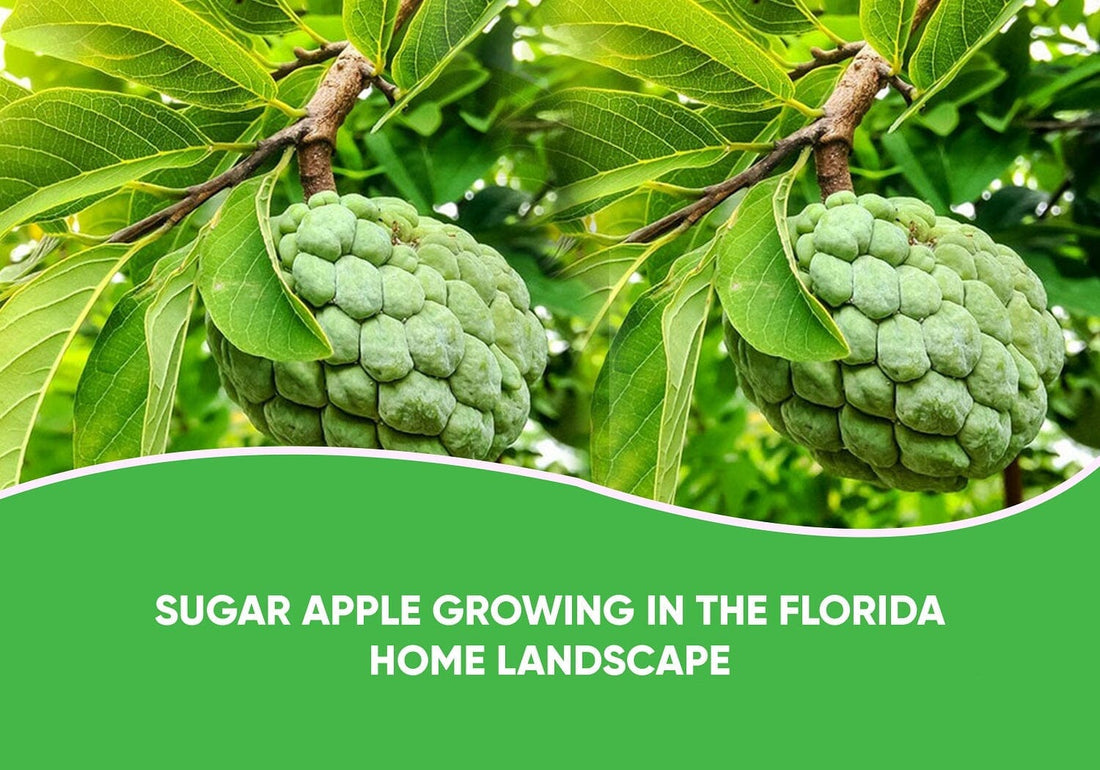
Sugar Apple Growing In The Florida Home Landscape
Share

Sugar apples, with their sweet and creamy texture, are becoming a backyard favorite in Florida. Not just because of their delightful taste, but also for their exotic appeal which turns any regular garden into a tropical paradise.
What is a sugar apple? A sugar apple is a tropical fruit known for its sweet, custard-like flesh and distinct bumpy green exterior.
Florida's climate is perfect for sugar apples. The warmth and humidity mirror the fruit’s native tropical regions. Gardeners in Florida have an edge. The soil type, often sandy and well-draining, aligns with what sugar apples prefer.
With the right care, these trees flourish, providing juicy fruits that are not just delicious but also packed with nutrients. It's no wonder then, that many Florida homeowners are choosing sugar apples. Given the state's favorable growing conditions, it’s a match made in gardening heaven.
Site Selection

When considering planting the sweet apple fruit, the first thing on your checklist should be site selection.
The soil should be your top priority. Sweet apple fruit thrives in well-draining, fertile ground. This ensures that the roots get just the right amount of moisture without becoming waterlogged. Sunlight is the next important area of concern. Sugar apple trees need plenty of sunshine. Aim for full sun exposure, ensuring the tree basks in at least 6 hours of sunlight daily.
Remember, give your fruit sugar apple the right start, and you’ll be rewarded with a thriving full-grown sugar apple tree in no time!
Planting

The first step is timing. It's best to plant between late winter and early spring. This period offers the tree ample time to establish roots before the hot summer months. The ground should be enriched with organic matter and, if necessary, undergo pH adjustments to suit the tree's requirements.
After this, comes spacing. Regardless of the variety, trees need room to spread their roots and branches. A spacing of 10-15 feet apart ensures optimal growth. If you have space constraints then you may also opt for a dwarf sugar apple tree for sale.
Sunlight and Temperature
Speaking of growth, sunlight plays a pivotal role. For flourishing blooms and fruit-bearing, the tree requires full sun exposure. Think of it as the tree's way of charging up.
Now, while the sugar apple flower loves the sun, it does have its comfort zone when it comes to temperature. An ideal temperature range for the tree lies between 50°F and 85°F. But here's a fun fact: these sturdy plants can tolerate temperatures up to 94°F.
Watering Requirements
Watering might seem simple, but it's more of an art when it comes to the sugar apple tree. In the initial stages, post-planting, frequent watering is essential for the first 3-4 weeks. This aids in root establishment.
Once the tree graduates to the 'established' category, the watering routine becomes less intense. A moderate watering once a week should suffice. But be cautious; these trees don’t appreciate waterlogged conditions. The key is good drainage to prevent root rot and other complications.
Fertilization
Initial planting should be complemented with a balanced fertilizer application to kick-start the growth process. However, as time goes on, one should look into nutrient-specific amendments. This is where soil tests come in handy.
They guide you on what your tree needs. And if you’re someone who leans towards the organic side of things, options like compost and well-rotted manure are your best bet.
Pest and Disease Management
Growing the sugar apple tree isn't just about planting and watering; it's also about guarding it against uninvited pests and illnesses. Common pests like aphids and mealybugs can be quite a nuisance.
These tiny invaders can compromise the health of your tree and reduce fruit yield. So, what's the shield against these pests? Regular inspections and preventive measures like applying neem oil work wonders. On the disease front, anthracnose and root rot are frequent culprits. But fear not! Timely identification and the right treatment can help mitigate these issues, keeping your tree hearty and robust.
Harvesting
The joy of seeing your tree bear fruit! But how do you know when the sugar apple is ripe for the picking? Indicators like a slight softness to the touch and a noticeable color change can help guide you. When it’s time to harvest, it's all about the technique.
Hand-picking is the way to go, and a gentle twist ensures you don't damage the fruit or the tree. Post-harvest, the fruits enjoy a cool, dry place. This not only preserves their freshness but also accentuates their sweet flavor.
Conclusion
Looking for high-quality plants to beautify your space? Dive into our collection, where quality meets diversity. From the lush red custard apple trees to the majestic Malay apple tree for sale, our offerings are meticulously cared for and primed for your garden. So, why settle for the ordinary when you can adorn your landscape with our well-maintained, premium selections?
Disclaimer- The information provided in this content is just for educational purposes and is written by a professional writer. Consult us to learn more about growing Logan trees.

